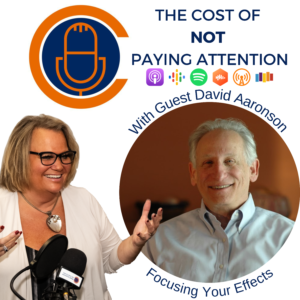
Companies often do not recognize the right person to sell to, which makes actually selling their product or service more difficult. Having alignment between your sales and marketing team means boosted revenue, profitability, and teamwork. To learn how to achieve this goal, Janine Hamner Holman interviews David Aaronson, the CEO of Digital Inbound. David talks about focusing on your niche, finding the right buyer persona, and finding the customer’s pain point. Learn how to get your marketing and sales force to work in harmony by tuning in.
GUEST: David Aaronson | LinkedIn |
HOST: Janine Hamner Holman | [email protected] | LinkedIn, Facebook, and Twitter | Subscribe to my Newsletter! Book me to Speak!
—
Listen to the podcast here:
Focusing Your Efforts: The Power Of Aligning Sales And Marketing
Exploring Marketing With David Aaronson
Welcome to the show. What am I paying attention to today? The high turnover of Chief Diversity Officers (CDOs). I was reading an article in the Wall Street Journal that was talking about how hard it is for organizations to keep their Chief Diversity Officers. The biggest reason that CDOs are leaving their jobs is that they can’t get the right resources in order to do their jobs well. I was thinking about one of the solutions for this, and one of the things that I work with organizations on, is bringing their Diversity Equity and Inclusion (DE&I) work into alignment with their mission, vision and values.
When your diversity work is connected to your organization at the level of its mission and values, it’s way easier to get the resources that those efforts need in order to be successful. Why was I thinking about all of that? Because I was thinking about this issue of alignment and how things don’t work when they’re out of alignment… which brings me right to our guest.
David Aaronson believes that there is an issue with the way that marketing is evaluated. He believes that the way that it’s decided whether a marketing effort is successful or not is based on the number and quality of leads and that’s exactly the wrong metric. Instead, David encourages organizations to evaluate marketing based on the profitability of the sales generated. He founded his company, which is called Digital Inbound, based on this principle.
He works with his clients to increase their sales, revenue and profitability by bringing sales and marketing into alignment. What he has found is that, in many companies, these out of alignment…and issues and several of the possibilities of change in alignment issues have been hidden right there in plain sight. How often does that happen? With that, let’s welcome, David.
Thank you very much. I’m pleased to be here.
I’m going to begin the way that I often begin, which is what is something that you have become aware of that you or others weren’t paying attention to either intentionally or unintentionally? What has been the cost of that not paying attention?
There are a lot of things.
It could be a big long list but what’s one thing that’s on your mind?
One thing that’s on my mind is the companies that I deal with in my business don’t do and don’t notice and they don’t notice exactly who they’re selling to? They don’t recognize the proper person that they’re selling to and therefore, their messaging is off. If the messaging is off, they’re not doing the best job that they can do marketing. That’s what I noticed and I’m constantly trying to refocus and realign those customers on their customers.
When you say that we’re not marketing to the right customer or we don’t have the right customer in our head when we’re thinking about marketing, how can we realign that? How can we get more in alignment, in addition to hiring your company, Digital Inbound? How can we get better about aligning?
Companies don't recognize the proper person they're selling to, so their messaging is off. If the messaging is off, they're not doing the best job that they can do marketing. Share on XSome things are easy and some things are a little bit more difficult. You have to refocus. I’ll give you two examples. One example is a company that did refurbished garages. It’s a simple business. Their website, when we took over the account, had pictures of men in their garages sometimes with cars and workbenches. We were doing some campaigns for them and we thought we could make the campaigns better. We asked them if we could interview some of their satisfied clients. They had done interviews of their satisfied clients and we said, “We want to talk to clients that are happy with your work. We just get some input. We had an ulterior motive in mind that you might be able to begin to surmise.”
We talked to four customers. All of them are married or have some opposite-sex spouses and indeed, the decision to do the garage refurbished 85% of the time, the woman was very much involved and sometimes predominantly involved. This is what we asked them to do, “Take all these pictures on the site, get some new pictures if you want. We’ll create the pictures for you or if you have them in your store, I’ll take pictures and let’s change about half the pictures.” We put women in the pictures because when someone comes to a site, they want to see themselves and they’re more likely to buy.
We changed 50% of the pictures and within a week, we had 20% more leads coming from the seller. It’s just that simple and it was a narrow focus. They were the men that created the company. Men, cars and their eyes are saying they are a perfect match to men and it was to some degree but they missed out on a whole buyer that was very important in a decision.
Sometimes, we see what we think we see and we think that’s all that needs to be seen and sometimes, we need to widen our gaze and then we can see everything that we need to see. I’ve got another example, this is a financial services firm and they were selling to the end-users. As a financial services firm, they ran very successful funds and they protected against the downside loss and a whole bunch of other stuff but they wanted a new website. I said, “Let’s take a look at who this website should be for? Who could you be selling to? I had them go through an exercise of creating buyer personas. Who is the buyer? What’s their pain? What are their challenges? What’s their goal? How would you speak to them?
It turns out they came up with four separate buyer personas, three that they weren’t selling to at all and when they were with the end-user consumer. We went through an exercise of how difficult it is to get to the end-user consumer and what would you be selling them? They had another buyer persona and those were small wealth managers that had a cadre of end-users who came to them to get advice on how to invest their money.
As we walked through the exercise, I could see actual light bulbs going off in her eyeballs. There are fewer of these people. They’re better well-defined. They all have their funds and money at the same company. In this case, it was Schwab. It will be easy to integrate with them and they go after the end-users. It’s a lot more expensive to go after end-users than be a B2B business, which is what they’ve now become. We’re now rebuilding their website with that focus in mind. I think it’s going to be a lot easier for them to make all their sales goals and practically exceed them because they’re selling to people who effectively sell to what used to be their end-user customers.
It’s now an entirely different buyer persona. It’s easier to communicate with them. You know their goals and challenges are better and easier. They were focused and the more niche focus you can be in your marketing, the better your marketing will be. One of the things that I say is not things are hidden in plain sight but there’s marketing. I can email, I can buy a list, as an example, an email to that list. That is marketing.

Sales And Marketing: The more niche focus you can be in your marketing, the better your marketing will be.
Anyone who creates a Google AdWords Campaign is marketing but that doesn’t mean that the Google AdWords Campaign is set up properly or as directly to the right buyer persona. We could do better marketing. There’s marketing and as lots of people that do marketing, very few people, unfortunately, align with their buyer personas, what their product is and create a better market.
In case any of our readers don’t know what B2B is, that’s Business-to-Business. Instead of direct marketing to consumers, which is often called B2C, Business-to-Consumer, I am going to purchase a lipstick and Maybelline is going to market to me Business-to-Consumer. This is Business-to-Business so then the business would be the one who is hiring this financial services company.
When we think about this idea of a buyer persona, I love this concept in terms of getting it more into our frame, our mindset around who is purchasing our products or services. I was having a conversation at a fundraising event. I was talking with somebody who was in sales and we got into talking about how much of our life, no matter who we are, what we do and what we’re selling somebody on something. I think we need to switch our toothpaste. We sell all the time as humans. Talk to me more about this buyer persona idea because I think you’re onto something here.
This is the single most important part of marketing besides having a product to sell. The next most important thing is who’s going to bite us? We need to talk about it in emotional terms, not in rational terms because its emotions are how we purchase them. I need to know in terms of the buyer, what are your pains? What’s painful for you? What’s irritating you? What are your challenges?
There are things that you want to do and you’re challenged to get them done and accomplished. You’ve set for yourself goals. What are those goals? If I know those things about you and I have a product that satisfies your pain, alleviates your pain, helps you get to the challenge and deal with the challenge that you have or helps you succeed in meeting your goals, you will buy my product.
It’s that simple and very few companies take a look at buyer personas. When I teach my digital marketing class, that UCLA extension, the first class I give an overview and then we start talking about buyer personas. There’s a large section on buyer personas. That’s the first half of the class, the second half of the class is we’re now going to talk about buyer personas but they haven’t even chosen their product yet. The course exercise is to create a marketing plan for the product. They haven’t even found the product that they’re going to market.
I start talking to them about buyer personas and how they need to define buyer personas. A buyer persona is a magical person that is the perfect customer for their product. Why is it the perfect customer for the product? It eases their pain, helps them achieve their challenge or help them make their goals. All of those things are emotional and are going to make that person feel better.
Sometimes, we see what we think we see, and think that's all that needs to be seen, but sometimes, we need to widen our gaze so we can see everything we need to see. Share on XI was on a group Zoom recently working with a bunch of advertising executives, who all happened to be men. They were saying to me, “I feel like I need to apologize because I have mostly spent my whole life making you feel bad about yourself so that you will buy my product.” They were lovely and gracious about making me feel bad so I’d buy their products. They did apologize for making me feel bad about myself… but they kept doing it! Except for a few of these gentlemen who were retired. It was a very interesting group as it included some mentors and their mentees…and a lot of the mentors had retired. It was a lovely moment…and all of the mentees are continuing to make me feel bad. It’s such an interesting lens to look through.
When I was young, my first real training after college was as a grassroots community organizer. I was lucky enough to be trained by the person who had trained Cesar Chavez. His core line was to forget all the numbers and statistics about whatever it is that you’re talking about and remember the story that impacted you, that had you want to work on this issue. Often we get into our heads or we feel like we need to prove something to somebody else about how smart we are, how on it we are, or how much research we’ve done about this. If we tell them a story and we impact their heart, that’s what’s going to move them towards whatever we’re interested in.
I’ll give you a contemporary one. I am adamant about doing things about the environment. I have driven an electric car for seven years. I am focusing on not using single-use plastic. It’s very difficult. They would understand the climate change is real. I’m worried about my grandchildren. I know all that stuff but we are destroying the Earth, etc. I’m doing this because I see my beautiful, wonderful grandchildren and what a world am I leaving them? What can I do to make their future and to ensure that they have a world to live in? That’s not based on facts. That’s my emotion, pure and simple.
Among the many other things that I am, I am a scuba diver and I love that experience of being in the ocean and being in something that is so much bigger and much more powerful than we are. I learned how to scuba dive when I was also the Chief Operating Officer for the Coalition for Clean Air, as I spent the first nineteen years of my life working for non-profit organizations. That sense of the world and both our smallness in it and our large ability to impact it is powerful. If you take your finger and you touch a piece of coral, that coral is now dead where you touched it. We have such an ability to impact the world both positively and negatively, understanding that, having something emotional that connects us to that,, and has a need to make a more positive impact.
You’re paying about it and it relieves our pain by doing something. What could I do? I can at least say, “I’m doing something.” Maybe I can get some others to do it and who knows how many lay down anyway. I want them to feel the pain too so do this and you’ll feel better about the pain.
Thinking about your grandchildren, I don’t yet have grandchildren… and I love the young people! Anytime I see a young person, I want to interact. Because of the symmetry of my face, they like me and often want to interact with me, which is wonderful. For me, to all the little cherubs out there makes me want to ensure that their planet is taken care of and ensure that other pieces of their world are taken care of, which is also part of why you and I do the work that you and I separately do.
I am often asked, “who is my ideal client?” I can sometimes get hung up in thinking about that. I can go too into my head. How would you encourage someone to start if they’ve never thought about this whether you’re thinking about it as a business owner, marketing executive, a spouse or as the parent of a child? As I said earlier, “We are always selling and marketing.” How can we think strategically about that?
There’s an easy answer. The easy answer is whatever it is you do, how does that help the person who purchases those services? In what ways does it help that person? Does that person have challenges that your product and service help them with? Does that person have some pain that your product or service helps them with? Are there some goals in their either personal life or in their working life that they have that your product or service can help them attain? If the answer is yes, you’re selling to the right person. If the answer is no, you’re wasting time.
Sales And Marketing: Within a business environment, what needs to be paid attention to is the integration of different departments that touch each other
Once you identify the pain, challenges, goals that the person needs to have then you go around what people have? Is that the Vice President of HR? Is that CFO or data operator? Now, you can focus on up. Maybe everybody in the HR department. If I talked to somebody who’s not in the HR department about my product deserves it, I’m wasting my time. I’m not talking to my buyer.
If we’re looking at an organization sometimes the people we are talking to have the pain but they’re not in a purchasing position. How do we help empower the people who have the pain but don’t have the purchasing power? How do we help them motivate the people with the purchasing power who may not also have the pain?
You need to explain how your answer will create more efficiency and effectiveness that can be turned into dollars. If you solve my pain and my challenge, you will make for the company X dollars because you’ll increase productivity, effectiveness, etc.
In a casual situation, I’ll have people who are talking with me about their organizational pain or the pain that they have in their organization. Sometimes it’s an educational institution and they’re a professor. They don’t have the ability to hire me but they certainly get what the dysfunction is in the organization. They often struggle with, “What do we do with that now?” I love that concept. If you had a magic wand, David, and you could have people pay attention to one thing either something that we’ve been talking about or something else, what would it be and why?
Within a business environment, what needs to be paid attention to is the integration of different departments that touch each other. The ones that I deal with the most but I’ve seen it prevalent in other organizations that should be close but are not are sales and marketing. Sales and marketing departments often are screaming at each other. We have statistics that show that we can improve the whole profitability of a company if we can get sales and marketing to talk to each other.
Think about the inefficiencies of both marketing and sales if they’re not in sync. If the payroll department is not in sync with the HR department, it should be because it’s underneath. If there are fights, “Don’t let them change the record this way. They’ve got it to change it that way.” You’re creating friction within your organization. If you get rid of that friction and then there will be more profitability with the entire organization.
It’s back to this idea of alignment. I want to ensure that our sales team and our marketing team are connected, communicating and interacting well. The idea of cross-functional teams is becoming more common and less siloed organizations where you have people working together on projects, I think it is a much more often effective way to go and it seems that sticks with what you’re talking about.
There are a lot of sales organizations and there are salespeople there. Salespeople ought to be the highest-paid people in the company. Making them more effective gives a better amount of money to the bottom line than working with any other work with your organization. If we make salespeople more effective, we save money for the company. There are lots of ways that we can make the salesperson more profitable. It’s because the salesperson is selling doesn’t mean they’re selling well.
There are lots of ways we can make the salesperson more profitable. Just because the salesperson is selling doesn't mean they're selling well. Share on XIf the marketing department is kept secret and they’re creating stuff for that buyer persona, the sales department is selling to a different buyer persona, and the information fed is going to the wrong persona then they’re not going to sell us more. If we can get them saying, “Sales department, tell us more about how you want this person qualified.” If there’s cooperation, I’ve now created effectiveness on the sales department and that’s going to affect my bottom line.
The more engagement, communication, synergy, alignment we can have, the more engaged and excited everybody is going to be about what they’re doing. Bottom-line profits are the end result of all of that.
We get, in some cases, to a written service level agreement between the marketing department and sales department, “We can do ten leads a week or whatever the number is with these qualifications. Sales department, you have to promise. You need to call that lead within X number of hours. You follow-up with an email within the next day. If you don’t, don’t yell at us.” The sales department says, “We’ll do that. We don’t want them qualified here. We want them to qualify on this and we don’t want them to qualify in that department. If you do that then we’ll do all of it.” “Great, let’s write that down. Agreed to and go.” It’s not difficult but they do have to talk civilly to each other.
There are so many things that are not difficult but can be hard. Getting that communication going so that everyone can be coming from it from a good place, from positivity, from the assumption of positive intent and then we all have the opportunity to move forward happily. Is there anything that I haven’t asked you yet that you would love for people to know, to be thinking about, a question that you want to leave people with or any way that you would like to begin to wrap this up?
All marketers think that we’re brilliant and think that we have the marketing answer. In reality, none of us do and behind the scenes, our biggest technique and method that we use constantly is testing. I would say most companies don’t test enough. Our salespeople have been selling like that for whatever. Let’s take two salespeople and try something different. Let’s see if it works. Let’s take one salesperson to have to do one thing, another salesperson do another thing and all the other salesperson do what they were always doing. Maybe there’s a better way and the fact of the matter is there’s always a better way. A good marketing person never stops testing.
I love that as an idea for life. Never stop trying out new stuff, never stop for a better way, and never think that you know all the answers or you’ve got it all handled because we are all works in progress. You and I don’t know it all so let’s try it out. One of the things that I keep reminding myself is that the smartest people that I know ask for help. They ask for support. They look to their resources and so often, we humans can get stuck in like, “I don’t want to show my vulnerability. I don’t want to come off as less than.” Lean in. Let’s lean into each other. Let’s lean into our resources. Let’s go to our trusted advisors and ask for help and support and like, “Can I pick your brain for a second?”
There’s no greater compliment that somebody can give me than like, “I have something I’ve been thinking about and I thought that you might be able to help me.” David, thank you so much for your time, wisdom, love of your grandchildren, great ideas around alignment and leaning in. This has been fun.
I enjoyed it too. Thank you very much.
It’s been my pleasure. Remember, great leaders make great teams. Until next time.
Important Links:
- Digital Inbound
- Schwab
- David C. Aaronson – LinkedIn
About David Aaronson








Israel Club
March 29, 2022 5:32 amMay I simply say what a relief to uncover somebody that really understands what theyre discussing over the internet. You certainly know how to bring a problem to light and make it important. More and more people really need to check this out and understand this side of the story. I was surprised that youre not more popular because you certainly have the gift.